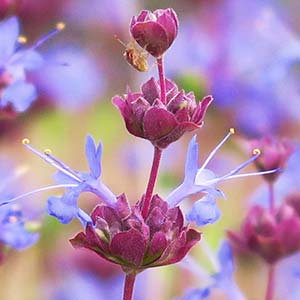Salvia dorrii
gray ball sage, purple sage
Leaves opposite, numerous, often in bundles, silvery with a close, mealy pubescence, the blade oblanceolate to elliptic, 1.5-3 cm. long and 4-15 mm. wide, narrowed to a short petiole.
Flowers in a series of dense, bracteate verticels at the ends of many of the branches;
bracts broadly elliptic to obovate, purplish, 7-12 mm. long, dry, granular on the back;
calyx two-lipped;
corolla usually bright blue-violet, I cm. long, two-lipped, the spreading, 3-lobed lower lip much longer than the short, flat, 2-lobed upper lip;
stamens 2, long-exerted;
style narrow, long, 2-parted;
ovary 2-celled, superior.
Nutlets 4
Salvia dorrii
Occurring east of the Cascades crest in Washington; Washington to California, east to Utah and Arizona.


